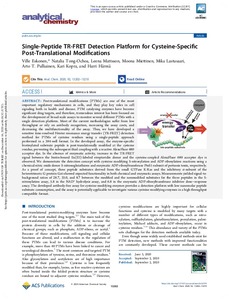Single-Peptide TR-FRET Detection Platform for Cysteine-Specific Post-Translational Modifications
Eskonen V; Härmä H; Kopra K; Lastusaari M; Mattsson L; Miettinen M; Pulliainen AT; Tong-Ochoa N
Single-Peptide TR-FRET Detection Platform for Cysteine-Specific Post-Translational Modifications
Eskonen V
Härmä H
Kopra K
Lastusaari M
Mattsson L
Miettinen M
Pulliainen AT
Tong-Ochoa N
AMER CHEMICAL SOC
Julkaisun pysyvä osoite on:
https://urn.fi/URN:NBN:fi-fe2021042822469
https://urn.fi/URN:NBN:fi-fe2021042822469
Tiivistelmä
Post-translational modifications (PTMs) are one of the most important regulatory mechanisms in cells, and they play key roles in cell signaling both in health and disease. PTM catalyzing enzymes have become significant drug targets, and therefore, tremendous interest has been focused on the development of broad-scale assays to monitor several different PTMs with a single detection platform. Most of the current methodologies suffer from low throughput or rely on antibody recognition, increasing the assay costs, and decreasing the multifunctionality of the assay. Thus, we have developed a sensitive time-resolved Forster resonance energy transfer (TR-FRET) detection method for PTMs of cysteine residues using a single-peptide approach performed in a 384-well format. In the developed assay, the enzyme-specific biotinylated substrate peptide is post-translationally modified at the cysteine residue, preventing the subsequent thiol coupling with a reactive AlexaFluor 680 acceptor dye. In the absence of enzymatic activity, increase in the TR-FRET signal between the biotin-bound Eu(III)-labeled streptavidin donor and the cysteine-coupled AlexaFluor 680 acceptor dye is observed. We demonstrate the detection concept with cysteine modifying S-nitrosylation and ADP-ribosylation reactions using a chemical nitric oxide donor S-nitrosoglutathione and enzymatic ADP-ribosyltransferase PtxS1-subunit of pertussis toxin, respectively. As a proof of concept, three peptide substrates derived from the small GTPase K-Ras and the inhibitory alpha-subunit of the heterotrimeric G-protein G alpha i showed expected functionality in both chemical and enzymatic assays. Measurements yielded signal-to-background ratios of 28.7, 33.0, and 8.7 between the modified and the nonmodified substrates for the three peptides in the S-nitrosylation assay, 5.8 in the NAD(+) hydrolysis assay, and 6.8 in the enzymatic ADP-ribosyltransferase inhibitor dose-response assay. The developed antibody-free assay for cysteine-modifying enzymes provides a detection platform with low nanomolar peptide substrate consumption, and the assay is potentially applicable to investigate various cysteine-modifying enzymes in a high throughput compatible format.
Kokoelmat
- Rinnakkaistallenteet [19204]
